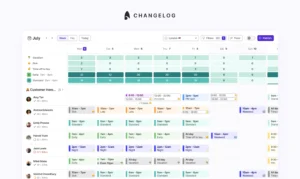
10 tips to optimise workforce scheduling in 2023

As we move into a new era where customer satisfaction and exceptional service are essential, capturing the true essence of workforce optimisation becomes increasingly challenging.
The objective remains to enhance productivity and efficiency while reducing operational costs.
This blog uncovers the secret of workforce scheduling optimisation. You will find 10 valuable tips to implement workforce scheduling optimisation in your organisation. But first, let’s look at the benefits of workforce scheduling optimisation.
Benefits of workforce scheduling optimisation
Workforce optimisation is a set of strategies and practices to improve employee and organisational efficiency while reducing operational costs using data.
Some of the key advantages of workforce optimisation include:
Cost reduction
Optimised scheduling helps to reduce labour costs by efficiently allocating the workforce based on demand. It ensures that an accurate number of employees with the appropriate skills are always available to prevent overstaffing or understaffing situations. Organisations can significantly reduce labour expenses by avoiding unnecessary overtime or idle time.
Improved productivity
Efficient workforce scheduling and forecasting scheduling ensures the workforce is deployed effectively for improved productivity. By aligning employee availability with peak demand periods, organisations can maximise output and ensure optimal utilisation of resources.
Enhanced customer service
Workforce scheduling optimisation allows organisations to match employee skills and availability with customer demand patterns. It ensures enough staff members to handle customer enquiries, requests, and support services for improved customer satisfaction. Satisfied customers are more likely to become advocates for the business.
Employee satisfaction and work-life balance
Optimised scheduling takes into account employee preferences, availability, and work-life balance. It helps distribute shifts and work hours fairly, reduces overtime requirements, and provides employees with more predictable schedules. Employee scheduling optimisation leads to increased employee satisfaction, improved morale, and reduced turnover rates.
Compliance with labour regulations
Workforce management scheduling software can assist organisations in complying with labour regulations, such as maximum working hours, break periods, and rest days. Businesses can avoid penalties and legal issues related to labour laws by automating the scheduling process and considering legal requirements.
Flexibility and adaptability
Optimised scheduling systems offer flexibility to handle unexpected changes in demand or staffing requirements. With real-time data and analytics, organisations can quickly adjust schedules, reassign resources, or call in additional staff when needed. This adaptability ensures the workforce can efficiently respond to changing business conditions and maintain optimal operations.
Data-driven insights
Workforce scheduling optimisation generates valuable data and insights for strategic decision-making. By analysing scheduling patterns, demand forecasts, and employee performance, organisations can identify workforce scheduling optimisation problems, optimise resource allocation, and make informed decisions about staffing levels and skills training.
Before we give you the 10 tips, here’s the process of workforce scheduling optimisation.⬇️
How to optimise your workforce schedules?
Start optimising your workforce schedules with these steps.
- Allocate dedicated time for optimising your workforce schedules.
For workforce management optimisation, dedicate specific time to focus solely on creating schedules. It ensures giving attention to building schedules and making informed decisions.
- Develop an efficient schedule template.
Developing a template is vital as a part of workforce optimisation strategies as it serves as a foundation for your schedules. This template should include fixed elements like working hours, break times, and other relevant information about your organisation.
- Enhance schedule readability for easy comprehension.
Use clear and concise language, and organise the schedule in a format that is easy for employees to understand. Consider colour coding or using symbols to indicate different shifts or roles for contact centre workforce optimisation.
- Strategically plan shifts around top-performing employees.
For optimal workforce planning and optimisation, identify your top-performing employees for workforce management optimisation and try to accommodate their preferred working hours whenever possible. It helps to boost productivity and morale.
- Provide schedules well in advance for effective planning.
Provide employees with sufficient notice before their shifts. Aim to publish schedules at least two weeks in advance, allowing them to plan accordingly.
- Empower employees to self-schedule when possible.
Consider implementing self-scheduling options where employees can input their preferred shifts or availability. This level of autonomy can enhance job satisfaction and work-life balance.
- Incorporate task management into your workforce scheduling system.
Integrate task management tools into your scheduling process to tackle any workforce scheduling optimisation problem.
It ensures that employees are assigned appropriate tasks during their shifts, maximising productivity and efficiency.
- Monitor and make changes.
Optimising workforce schedules is an ongoing process. Ensure a consistent flow of employee feedback, closely monitor the efficacy of schedules, and promptly adapt as needed to uphold a highly organised and productive workforce.
10 tips for workforce scheduling optimisation
Below is the list of the top 10 workforce optimisation strategies for organisations to implement.
1. Adopt a customer-centric approach
For workforce management optimisation, prioritise customer needs and preferences when creating workforce schedules. Consider peak hours, busy periods, and customer demand to ensure adequate coverage and excellent service.
A customer-centric approach helps avoid overcommitting resources and ensures customer expectations align with available staffing levels.
Here are a few ways to adopt a customer-centric approach to optimise workforce:
- Gather feedback and listen to customer concerns.
- Personalise the customer experience.
- Anticipate customer demands and provide proactive solutions.
- Prioritise timely and effective communication with customers.
- Continuously improve products and services based on customer feedback.
- Train employees to prioritise customer satisfaction.
- Measure and track customer satisfaction metrics.
2. Provide employees with the tools and resources
Proper tools and resources enable employees to perform their tasks accurately and reliably. For example, using advanced scheduling software can help eliminate errors in shift assignments, time tracking, and attendance management.
By providing employees with the right resources, they can quickly adapt to changes in the schedule or handle unforeseen circumstances.
For example, having cross-training resources available allows employees to fill in for absent colleagues, minimising disruptions to the schedule.
3. Match skills to jobs and tasks
Assign employees with the appropriate skills and experience to specific tasks. Ensure that each team member is assigned tasks that align with their strengths and expertise, optimising productivity and job satisfaction.
Matching tasks to employee skill sets for workforce planning and optimisation ensures that work is performed efficiently and effectively. It leads to increased productivity and streamlined operations.
4. Invest in a scheduling tool
Using a scheduling tool is significant for workforce management optimisation. A scheduling tool offers numerous benefits and efficiencies that manual scheduling processes cannot match.
A top workforce scheduling includes a few distinct features crucial for tackling Workforce scheduling optimisation problems.
- Forecasting
- Shift Planning
- Activity Scheduling
- Communication or notifications
- Easy editing tools to make changes on the fly
Surfboard is one such highly-rated workforce scheduling tool that offers advanced features. It has a user-friendly and intuitive interface and accurately manages scheduling across time zones. Here are Surfboard’s top five features.
Integrates forecast adjustment features into your workforce management system, allowing managers to adjust forecast volume for specific periods manually.
Provides intuitive shift planning, automates shift assignments up to 8 weeks in advance, and uses historical ticket data to predict future demand and determine staffing requirements up to 12 weeks ahead.
Surfboard’s activity plans feature allows you to schedule your team’s time differently. You can input rules for each channel and task to align the schedule to your priorities and needs.
Surfboard offers seamless integration with Slack, keeping support teams connected throughout the day. It also sends shift reminders and notifications for schedule changes, allowing agents to focus on helping customers.
Surfboard offers draft shifts exclusively visible in the planner, providing a secure space for editing and collaboration among team leads.
5. Set realistic goals
Realistic goals for workforce management optimisation align with the organisation’s capacity, consider workforce capabilities, and aim to maximise operational efficiency while maintaining a healthy work environment.
Setting realistic goals is crucial for workforce scheduling optimisation. When goals are realistic, they are more attainable and can be effectively integrated into the scheduling process. On the other hand, unrealistic goals can lead to burnout, poor performance, and decreased morale. When setting goals consider the following:
- Workforce capacity and capabilities
- Available resources and budget
- Operational constraints and limitations
- Current workload and productivity levels
- Employee skills, training, and well-being
- Customer demand and expectations.
- Organisational objectives and priorities.
6. Be agile
Embrace flexibility and adaptability in your scheduling approach to deal with workforce scheduling optimisation problems. Anticipate and respond to changing demands, unforeseen events, and employee availability.
Agility allows you to make real-time adjustments to the schedule, ensuring you have the required number of employees in the right place at the right time.
Further, considering employee preferences in scheduling makes them feel more valued and motivated. It can lead to improved morale, reduced absenteeism, and increased productivity.
7. Monitor and analyse performance metrics
Continuously monitor and analyse relevant performance metrics related to workforce scheduling, such as employee attendance, productivity, customer satisfaction, and employee turnover rate. It will help you identify areas for improvement and make data-driven decisions to optimise future schedules.
Some key metrics to monitor and analyse performance for workforce planning and optimisation:
- Employee attendance and punctuality.
- Schedule adherence and compliance.
- Productivity levels and output.
- Customer satisfaction ratings and feedback.
- Response times and service level agreements.
8. Make smart hiring choices
The quality of your workforce directly impacts scheduling efficiency and overall operational performance. By hiring well-qualified and skilled individuals, you can be sure to have the right people in the right roles.
When you hire employees with the right skills, knowledge, and experience for their designated positions, they are more likely to perform their tasks well. It minimises errors, reduces the need for constant supervision, and improves overall scheduling efficiency.
9. Enhance your scheduling process
A well-designed schedule considers employee availability, skills, workload distribution, and business needs. By creating improved schedules, organisations can achieve maximum productivity, minimise downtime, and enhance employee satisfaction in contact centre workforce optimisation.
- Maintain efficient resource allocation. Match employee expertise to job requirements.
- Balance workloads among employees to equally distribute tasks, maintaining a healthy balance for all employees.
10. Respond to business needs
Staying informed about evolving business requirements is one of the crucial workforce optimisation strategies for workforce scheduling optimisation. Consider factors like fluctuating customer demand, seasonal variations, project deadlines, and other variables affecting workforce requirements. By being proactive and responsive, you can make informed scheduling decisions that align with your business objectives.
Flexible scheduling allows you to adapt swiftly to unexpected changes like employee absences, shift swaps, or urgent tasks. You can ensure uninterrupted operations and a seamless workflow by having contingency plans and backup resources.
Wrapping up
The changing business landscape demands agility. Organisations must be proactive and open to embracing innovative solutions that align with their evolving contact centre workforce optimisation needs.
Make sure to include the unique requirements of your contact centre when optimising workforce scheduling. Implement a robust workforce optimisation model to create a workforce optimisation example that sets the stage for success.
Discover how Surfboard can help you optimise workforce scheduling. Book a demo today!
FAQs
What are the benefits of workforce optimisation tools?
The benefits of workforce optimisation tools include improved efficiency, enhanced productivity, accurate scheduling, reduced costs, better resource allocation, increased employee satisfaction, and improved customer service through optimised staffing levels and streamlined operations.
Why is workforce optimisation important?
Workforce optimisation helps organisations maximise their workforce’s potential, minimise inefficiencies, and achieve optimal performance. It ensures that the accurate number of employees with the right skills are scheduled at the right time, improving productivity, customer satisfaction, and cost-effectiveness.
How do we integrate workforce scheduling with workforce forecasting?
Integrating workforce scheduling with workforce forecasting involves aligning the projected demand for labour with employee scheduling. By analysing historical data, market trends, and business forecasts, organisations can forecast their labour requirements and schedule employees accordingly, ensuring adequate coverage during peak periods.



